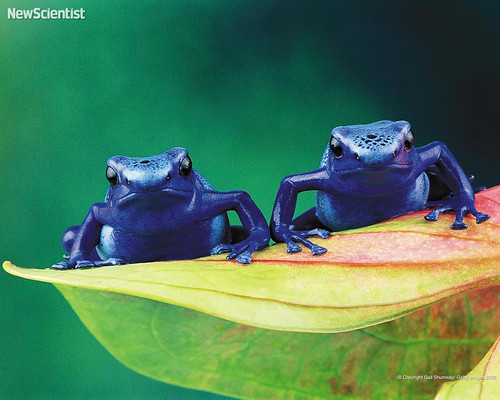tags: blue poison dart frogs, Dendrobates azureus, Dendrobatidae, NewScientist, Image of the Day
Blue Poison Dart Frogs, Dendrobates azureus.
Dendrobates azureus is a species of poison dart frog found in the Sipaliwini District in Suriname of South America.
Image: Gail Shumway/Getty Images 2007 (NewScientist calendar 2008). [Much larger view]
The poison dart frog is the common name for the Dendrobatidae family of small, diurnal frogs that are endemic to Central and South America. These frogs are widely referred to as poison arrow frogs or poison dart frogs, which reflectes the widespread notion that all "poison" frogs are used by South American tribes in the manufacture of poison that is spread on arrows or blow-gun darts. In reality, only three species (there are more than 175 so-called "poison arrow frog" species) are toxic enough to use for this purpose, and none are Dendrobates species, although the Dendrobates species are typically characterized by their brilliant colors and complex patterns.
- Log in to post comments



I wonder what that pair are looking at?
I suspect that some insects are soon to be meals.
Oooohhhhh.... those are pretty!
Oooohhhhh.... those are pretty!
Posted by: Alex | December 28, 2007 3:42 PM
I agree with Alex. They may not be deadly, but they sure are pretty! Come to think of it, deadly and pretty don't usually go together that well anyway! LOL!
Dave Briggs :~)
I think they've just found me guilty. I'm scared.
Bob
Very cool pic :)
The colours are beautiful
In reality, only three species (there are more than 175 so-called "poison arrow frog" species) are toxic enough to use for this purpose...
And as you (IIRC) posted a while ago, even those don't actually produce their poison, they acquire it from their diet.
It is true, that in captivity the poison arrow frogs generally aren't poisonous, and the dendrobates are generally not very poisonous, but they are still slightly. The most toxic of the poison arrow frogs is the phyllobates terribillis, usually the small green frog. They generally can be held in captivity. The poison that they produce isn't aquired from their diet, however some of the micro, and macro nutrients required to produce the poison is only found in the poison arrow frogs diet in the wild.
It is true, that in captivity the poison arrow frogs generally aren't poisonous, and the dendrobates are generally not very poisonous, but they are still slightly. The most toxic of the poison arrow frogs is the phyllobates terribillis, usually the small green frog. They generally can be held in captivity. The poison that they produce isn't aquired from their diet, however some of the micro, and macro nutrients required to produce the poison is only found in the poison arrow frogs diet in the wild.